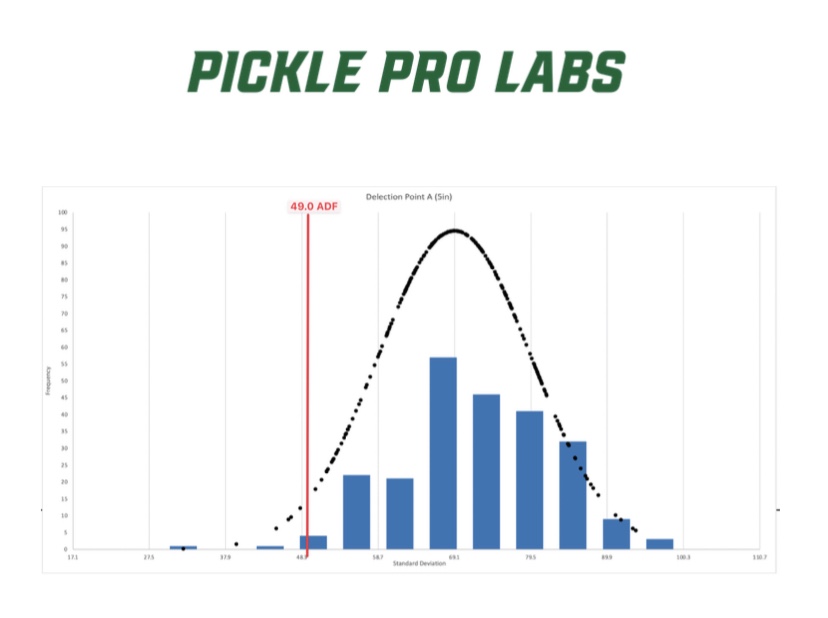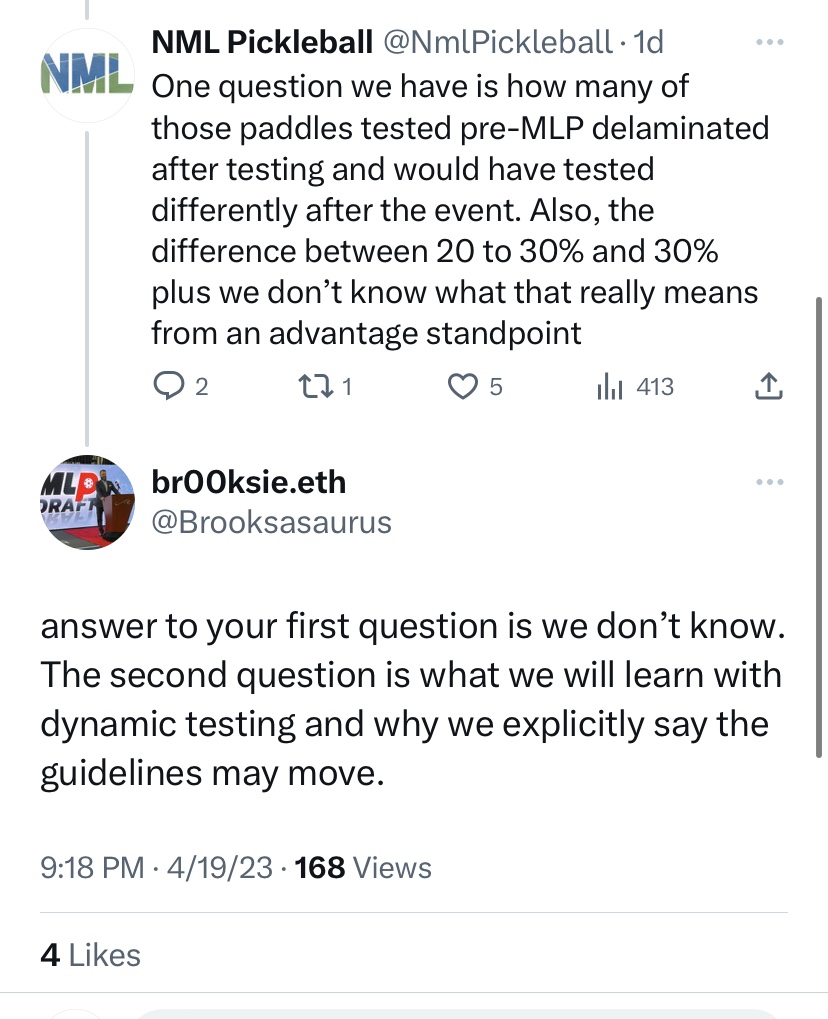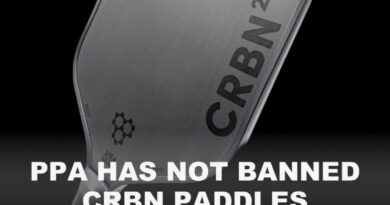MLP Releases Daytona Paddle Testing Findings – What Have We Learned?

We are fresh off a bunch of paddle controversy from the PPA Red Rock Open so there was no better timing for Major League Pickleball (MLP) to release its paddle testing findings from the data that was collected at the Daytona MLP event at the end of March. MLP published a press release and attached the report from Pickle Pro Labs (PPL), a company retained by MLP and the PPA to conduct the independent paddle testing. The report included the complete results of the anonymized testing data that was collected.
The public release of the report from PPL is a refreshing change of pace from the opaque paddle testing process we have seen from USA Pickleball and the PPA Tour over the past 9 to 12 months. Regardless of what we can glean from the results, this is a vital first step taken by MLP and the PPA to implement proper standards and guidelines for paddle testing in the sport.
You can read the PPL report for the explanation on the data. The gist of it is that they tested for deflection and surface roughness (i.e. grit), but the crux of the report revolved around deflection. Average Deflection Force (ADF) threshold was the measurement used to test for deflection. The lower the ADF, the faster the ball will come off the paddle. The testing resulted in an ADF for the entire group of paddles and the outliers from that average were measured on a percentage basis to create PPL’s preliminary recommendation on allowable ADF threshold.
The report states that “nearly eighty percent (80%) of all paddles tested fell within 20% of the ADF” while 2.5% of paddles were more than 30% below the ADF. The preliminary recommendation in the PPL report is that 30% is an “appropriate deviation” to establish as the threshold for what should not be allowable outside of the range of the ADF. In non-engineering speak, the report set out that 6 paddles from 4 manufacturers (and 6 paddle models) would have been removed from MLP Daytona based on the pre-tournament testing. PPL contacted all the players and manufacturers whose equipment tested outside of the preliminary recommended guidelines.
So, what can we takeaway from all of this?
2.5% or 6 total paddles sounds like a small number. It would be easy to conclude from those numbers that the paddle problem is not nearly as bad as it may seem with all the attention the topic has been receiving. We don’t think it is as simple as that, though.
The first question that came to our minds is whether the testing would have returned the same results post-MLP. We know the biggest problem is that paddles get approved in the current testing environment when new but they delaminate after use or through other human intervention. Would any more of these paddles tested outside of the 30% range if the testing was done during or after MLP? We don’t know the answer to that, but we have to take the 2.5% number with a grain of salt because of what we know about paddle delamination.
It should be noted that the PPL report also notes that the current deflection testing is not sufficient and built its testing methodology around the same principles used in NCAA baseball and softball as well as clubface deflection in golf. Ben Johns also mentioned on the Pickle Pod that the principles used to test baseball bats would be more reliable than the current testing methodology for deflection.
Another question we have to ask about the results is whether any players intentionally chose to provide paddles for testing that were more likely to fall within an appropriate ADF range and/or grit. While MLP was clear that the data collected would be anonymous, the press release from MLP also stated that PPL contacted all players and manufacturers whose equipment was “found to have significant deviations” outside of the guidelines laid out in the report. The fact that testing was being done could have led some players to decide against using a paddle that were more likely to be significant outliers to the average paddle. We have no idea if this occurred, but it is a question that must be asked.
We have reported in the past, and it has become clear since that time, that players are modifying their paddles. Rightfully, the data in the PPL report will remain anonymous to anyone outside of PPL. However, only PPL will be able to tell from this set of data whether certain players are using paddles that significantly deviate from the version of the paddle that was approved by USA Pickleball. Who knows. There may not have been any paddles that fall into this category, but we won’t have any way of knowing as the report does not make any reference to the possibility of paddles testing significantly outside the ADF or surface roughness range of its USA Pickleball approved specifications.
The final thing we want to discuss as complete non-experts on this subject is what the difference between the 20% to 30% lower than the ADF means compared to lower than 30% of the ADF. Although the PPL report recommends more than 30% below the ADF as the threshold, the report also acknowledges that “the exact significance of such a low deflection force has not been experimentally determined.”
The whole point of testing is to create a level playing field and ensure the game on the court is fair for everyone. If the recommended threshold was more than 20% below the ADF rather than 30%, suddenly we are at more than 20% of paddles that would have been removed from play at MLP Daytona. This is simply a hypothetical, but the report is clear that more testing has to be completed to “properly quantify paddle performance and how it correlates to deflection force.”

The report takes what it describes as a “conservative approach” and there will be more learning to be done after “dynamic testing. The individual spearheading this initiative, MLP Commissioner, Brooks Wiley, responded to our initial reaction tweet noting that MLP explicitly states the recommended guidelines may move after further dynamic testing. Of course, MLP and the PPA have no obligation to accept whatever the final recommendation from PPL ends up being. It will ultimately be up to them to interpret the data and make a final decision on the allowable threshold range for deflection.
Grit is not the big issue these days but we should mention that the average surface roughness (i.e. grit) for 19 unique paddle models exceeded the thresholds established by USA Pickleball.
Our overall take on this PPL Report is that we should not be jumping to any grand conclusions. We have a few questions as we noted in this article, but those are not questions that can be answered at this time. We recognize this is the first step on a journey that hopefully will conclude sooner rather than later. Rome wasn’t built in a day. All that jazz. The important thing is that a real step has been taken in this process.
The final question we want to ask is if MLP will have a paddle testing standards policy in place by the time San Clemente rolls around in the middle of June. If so, what will it look like? If not, how long is it going to take to get something in place? Just because standards are created, it does not mean those standards can’t be refined after implementation.
We’ll have to be patient and trust that the decisions made based on the data collected will be best for the long-term interests of the sport.
Agree or disagree? Let us know in the comments below or email us at nmlpickleball@gmail.com. Follow us on Twitter, Instagram and Facebook, and also make sure you subscribe to our newsletter for fresh content!



Thank you for your time and posting. When I lived in Australia in the ’90s, an independent study was conducted for an electric company to see if power lines affected cows who grazed underneath them. The report turned out negative for the electric company. But because they paid for the report, they were able to just change the results and put in a more favorable outcome, it was their report.
Paddlepandamonium conspiracy theory:
PPL, “Here’s your report MLP/PPA”.
MLP/PPA, “What? 20% of paddles, around 120, didn’t come up to code? Sh*t, we’re going to look like f$%#*&^ idiots. Hey, PPL, what happens if you use 30% under recommended threshold instead of 20%? Only 6 paddles. Shewww. Okay, people, we have our guidelines… Lunchtime.” 🙂
Who knows. You are always very skeptical, David!
It’s clear for many reasons that we are not there with paddle testing yet. But the fact that testing is happening and there’s transparency (at least with these results) and some level of dialogue is encouraging and a sign that things are moving in the right direction. I think that’s all we as fans can ask for at this point. They don’t have all the answers, but (I’m hoping) they are working on getting them.
100% agree here.
Pingback: Sarah Ansboury Defaulted as Gamma Paddle Fails PPA Tour On-Site Testing – NML Pickleball
Pingback: MLP San Clemente – Live Random Thoughts – NML Pickleball